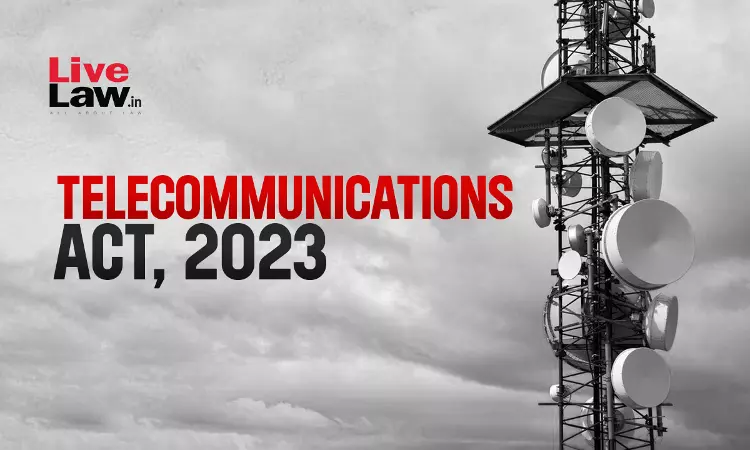Balancing Innovation And Rights: Evaluating India's Telecommunications Act Of 2023
Sneha Singal
12 Jan 2024 5:12 PM IST

India's telecom sector has undergone a significant transformation from its early days governed by outdated laws like the Indian Telegraph Act of 1885[1], the Indian Wireless Telegraphy Act of 1933[2], and the Telegraph Wires (Unlawful Possession) Act of 1950[3]. The recent repeal of the 1950 Act in 2023 is a key move in updating the sector's regulations.
These old laws were essential in their time, shaping communication through coded messages on wires. However, as technology evolved, we witnessed a shift from this to a complex system of real-time multimedia communication. The discontinuation of telegraph services in 2013 opened doors to diverse communication forms like voice calls, SMS, radio, television, and internet-based services like messaging and video calls[4]. Technology's evolution blurred boundaries between services, allowing similar offerings across different mediums. For instance, cable TV networks began providing internet, and the internet was used for public broadcasting. Acknowledging this change, the Department of Telecommunications recognized the need to update regulations.
Efforts to modernize these laws started with the Communication Convergence Bill of 2001, aiming to replace outdated telecom laws. Following this, the draft Indian Telecommunications Bill of 2020[5] sought public input to revamp regulations. Now, the Telecommunications Act 2023[6], approved by both the houses of the Parliament and subsequently endorsed by the President on 24 December 2023, signifies a concentrated effort to replace old telegraph laws and establish modern regulations suitable for today's dynamic telecom landscape. The statute signifies a crucial step in creating a comprehensive legal framework to meet the evolving demands and complexities of India's thriving telecom industry.
The Telecommunications Act of 2023 encompasses several key advantages aimed at regulating and enhancing the telecom sector. Firstly, it mandates prior authorization from the central government for telecom-related activities[7], ensuring oversight and control over services, network expansions, and possession of radio equipment. Secondly, spectrum assignment through auctions[8], except for specific purposes like national security or disaster management, ensures efficient allocation. Thirdly, the statute also grants powers of interception[9] and search[10], allowing necessary actions in the interest of public safety or emergencies, subject to prescribed procedures and safeguards. Also, it focuses on user protection, enabling consent mechanisms for specified messages, creating Do Not Disturb registers, and establishing grievance redressal mechanisms[11]. Fourthly, the legislation addresses the right of way for telecom infrastructure on public or private property[12], ensuring fair and non-exclusive access. Amendments to the TRAI Act for appointments[13] and the establishment of the Digital Bharat Nidhi[14] for telecom development in underserved areas further underscore the statute's comprehensive approach. Lastly, it also outlines stringent penalties for offences, establishes an adjudication process with tiers of appeal, ensuring accountability and enforcement.
However, the Telecommunications Act, 2023 has substantial issues and drawbacks that need to be addressed. Some of the primary concerns within the Act are outlined below:
- Lack of explicit safeguards: The absence of specific procedures and safeguards outlined within the Act itself is a significant drawback. Delegating these critical aspects to government rules raises questions about transparency and protection of individual rights. Explicit safeguards are essential to prevent potential misuse of interception, monitoring, or blocking of communications.
- Insufficient oversight mechanism: The existing oversight mechanism, primarily constituted by senior government officials, might not suffice as an effective safeguard. This structure could conflict with the principle of separation of powers, potentially leading to unchecked government actions.
- Risk of extensive surveillance: The broad language of the Act enables the interception of all communications based on specified grounds, potentially leading to mass surveillance. Such extensive monitoring could infringe upon the fundamental right to privacy for all users without proportional justification for such intrusion.
- Lack of safeguards in search and seizure powers: The absence of specified safeguards for search and seizure actions authorized by the central government raises concerns. Stringent statutory conditions are typically imposed on such actions, ensuring accountability and protection of individual rights.
- Biometric verification concerns: Requiring biometric-based identification for user verification might be disproportionate and could infringe upon the fundamental right to privacy. The imposition of such intrusive measures raises questions about the necessity and proportionality of such requirements.
- Limitations on SIM card usage: The imposition of penalties for using SIM cards in excess of a notified number without defining a legal limit for usage raises ambiguity and potential enforcement challenges.
- Centralization of regulatory powers: Delegating regulatory functions to the central government instead of an independent regulatory body like TRAI raises concerns about concentrated power and potential conflicts of interest.
- Legislative integrity and authority: Granting the central government the authority to modify civil offences and penalties through notifications might undermine the legislative process and raise questions about the arbitrary use of power.
Addressing these concerns is pivotal to ensure a comprehensive legal framework that not only fosters the growth and regulation of the telecom industry but also prioritizes individual rights, privacy, and fair oversight. Striking a balance between enabling innovation and safeguarding fundamental rights will be crucial in crafting a telecommunications law that truly meets the evolving demands of the sector while upholding constitutional principles.
Views are personal
[1] INDIAN TELEGRAPH ACT, 1885.
[2] INDIAN WIRELESS TELEGRAPHY ACT, 1933
[3] TELEGRAPH WIRES (UNLAWFUL POSSESSION) ACT, 1950
[4] Sandeep Joshi, Dot, dash, full stop: Telegram service ends July 15, THE HINDU, Jun. 12, 2013,
[5] INDIAN TELECOMMUNICATIONS BILL, 2020
[6] INDIAN TELECOMMUNICATIONS ACT, 2023.
[7] INDIAN TELECOMMUNICATIONS ACT 2023, s. 3.
[8] INDIAN TELECOMMUNICATIONS ACT 2023, s. 4.
[9] INDIAN TELECOMMUNICATIONS ACT 2023, s. 20.
[10] INDIAN TELECOMMUNICATIONS ACT 2023, s. 43.
[11] INDIAN TELECOMMUNICATIONS ACT 2023, s. 28.
[12] INDIAN TELECOMMUNICATIONS ACT 2023, s. 11.
[13] INDIAN TELECOMMUNICATIONS ACT 2023, s. 39.
[14] INDIAN TELECOMMUNICATIONS ACT 2023, Ch. V.


